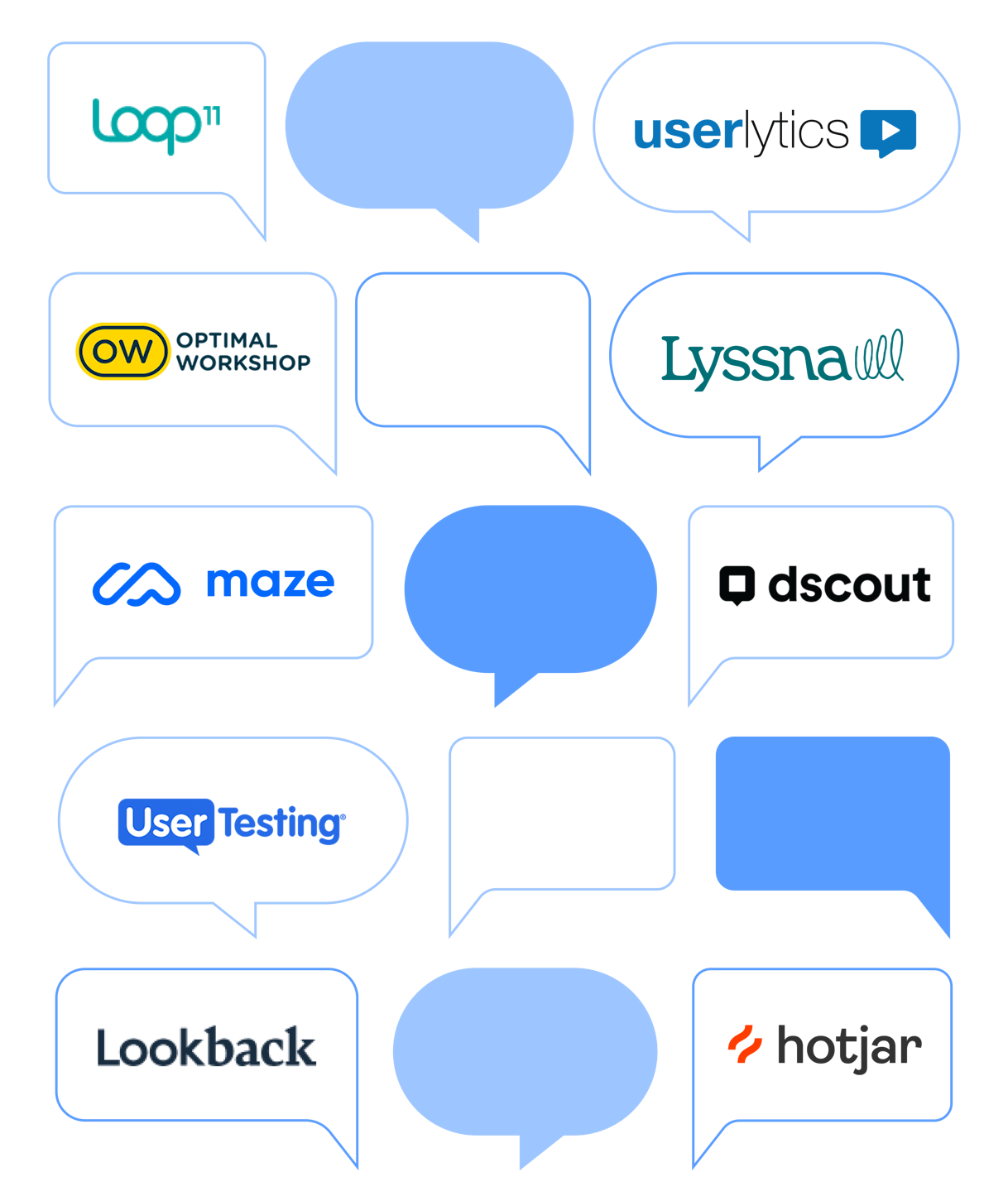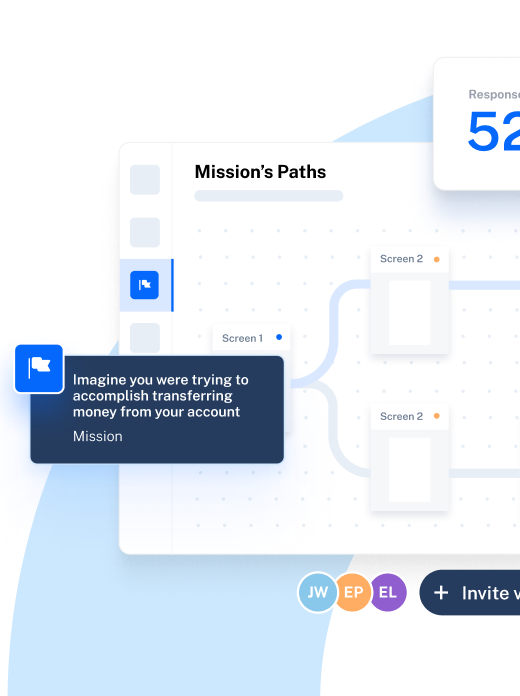dscout is known for its remote user research tools, including diary studies and participant recruitment features, making it a go-to for easy qualitative insights.
But it might not check all the boxes on your UX research wishlist. dscout often falls short in key areas like integrations and quantitative research. Add in the higher price tag, and many teams start looking elsewhere.
If that’s where you are right now, you’re in the right place. From pricing tables to top features, here are the top eight dscout alternatives to consider for your team.
Top 8 dscout alternatives: An overview
We’ve rounded up the best dscout competitors and outlined pros, cons, and pricing, giving you a clear look at how they measure up. Let’s find the perfect fit for your team.
Tool | Research methods and features | Pricing starts at | G2 rating | G2 reviews |
|---|---|---|---|---|
dscout |
| Custom (reportedly starts at $75,000/year) | 4.3/5 | “It's a complicated platform. Each time our team runs our quarterly study, we end up with questions or problems we need to reach out to customer support on. While the chatbot and the folks helping there are wonderful, it feels cumbersome. It's as if we never really know all the features or exactly what will go wrong.” "Dscout is costly--especially for small teams and non profits!" "Pretty expensive, and most of my analysis happens outside the platform (as opposed to using analysis tools they offer in the platform) so I wonder if they could build and provide more tools for that." |
Maze |
| $99/month, billed monthly or annually | 4.7/5 | “Maze is easy and fun to use, integrates nicely with Figma, and we love the ability to bulk upload our own research participants." "We use Maze on a weekly basis and can move from identifying a research need to having critical insights in a matter of days when it previously took multiple weeks." "The AI features are some of the most effective and helpful I've seen as compared to other software products.” "Maze provides advanced features, the interface is so intuitive, making it easy for beginners to adopt and use." "Maze has it all, from Quantitative Research and prototype usability metrics to Qualitative Research, analysis and reporting! Maze covers the whole spectrum of a research process, even including recruiting participants that fit your target segments." |
Userlytics |
| $499/month, or $99/session for one-off projects | 4.4/5 | "The quality of testers isn't always great, they don't always seem to have passed the requirements or qualifying questions at the beginning of the test." “Increasing the representation of users across different regions, languages, and specific niche groups could provide more comprehensive feedback.” "Needing to reach out to support to do basic tasks like rescheduling participants is not efficient and slows down the work." "The transcription has a lot of problems when the person has an accent, and since it's used in the IA analysis we can't trust the analysis and we can't use it." "I've found that it is not an intuitive platform to learn quickly & our team ends up quite frustrated trying to jump in & run moderated interviews." |
UserTesting |
| Not shared publicly, but users report that pricing starts at $20,000 per seat/year, billed annually | 4.5/5 | “Very confusing pricing structure that feels like smoke and mirrors at times." "Low level of trust in their panel - a lot of "testers" that come across as falsifying screener responses for incentives.” "One downside is the quality of participants at times. There are professional test takers and bots trying to simply make money." "For being a platform dedicated to helping people improve their user experience, some of the UI elements and navigating the platform is clunkier than I would have expected." |
Optimal Workshop |
| $107/month, billed annually | 4.5/5 | “Can’t export my themes and observations to Miro. Sometimes performance is an issue when my studies get larger.” "There is a limitation on screening questions so you have to be cognizant regarding who you want your audience to be." "I found it hard to aggregate user answers for post-test questions." "Ofter the users who participate in the usability testing do not provide genuine results." |
Hotjar |
| $32/month, billed annually | 4.6/5 | “Some features are blocked behind a payment wall, and the organization of sites and companies can be confusing at times.” "The freemium option is nice for small startups ." "The dashboard experience can be likened tool that one cluttered drawer everyone has at home - full of useful stuff, but you need to rummage." |
Lookback |
| $25/month, billed annually | 4.3/5 | “Some participants had trouble getting into a session through the tool. They needed to download the app and allow several permissions.“ "Users have a lot of difficulty with the plug-in, which sometimes causes no-shows. I found out that some of the users came to the session, but we could not see each other for some reason." |
Loop11 |
| $179/month, billed annually | 4.4/5 | “The limited customization options for usability tests and surveys hinder our ability to tailor the platform according to our research needs.” "The pricing plans provided are not reasonable." "There is a lack of accessibility analysis and responsiveness testing for web applications. The API for regression testing is not very good either." |
Lyssna |
| $75/month, billed annually | 4.5/5 | “Not many users for interviews from non-English speaking countries, I wish there was a larger panel for interviews. Desktop and mobile testing doesn't have feature parity.” "Has limits when it comes to completing reliable and valid user research." "The reporting is a bit clunky to use, but gets the job done and has what you need." "The pricing can scale up quickly, especially if you're conducting frequent analyses." |
1. Maze: Best for comprehensive UX research
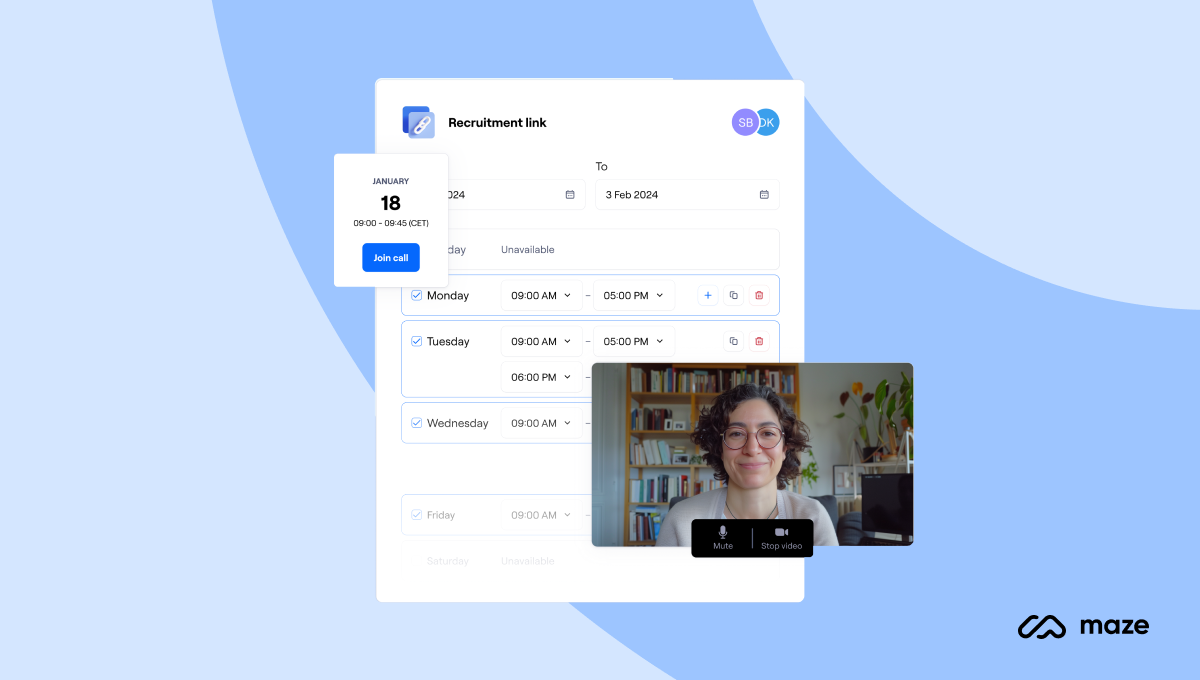
Maze is the UX research platform that makes user insights available at the speed of product development. With both moderated and unmoderated research methods, Maze empowers your UX team with a comprehensive suite of research methods to create truly user-centered designs.
As a holistic UX research platform, Maze goes beyond user testing—offering participant recruitment and management solutions, a variety of user research templates tailored to different research needs, and advanced AI features for data analysis and reporting.
Plus, Maze also integrates with your favorite tools—such as Figma, AdobeXD, Sketch, Slack, and Amplitude—to share insights across your team and incorporate user feedback into your design and development processes.
Pros
- Extensive research methods: Maze’s complete suite of moderated and unmoderated features makes it easy to get the exact insights you need wherever you are in the product development process
- Maze AI: Streamline your UX workflow with bias-free question generation, automatic project naming, and interview analysis to highlight key learnings
- Recruit with Maze Panel: Maze’s pre-screened participant panel delivers extensive user feedback from your target demographics with 400+ filters and 130+ countries to choose from
- Participant management with Maze Reach: Once you’ve recruited research participants, Reach lets you track their participation and create custom recruitment campaigns for future studies
- In-depth analysis and data reports: Maze automatically analyzes your user feedback and puts crucial findings in customizable, visual-rich, UX research reports
- Get audio and visual recordings: Alongside moderated user interviews, Maze Clips lets you record your participant's screen and audio, for quickfire moderated usability testing sessions
- Integrate with your existing tool stack: Integrate with the tools you already use in your design and development process, such as Figma, Sketch, Adobe XD, Slack, and more
Cons
While users can access Maze through web browsers on mobile devices, there isn’t (yet) a dedicated mobile app
Pricing
Free | Starter | Organization |
|---|---|---|
$0/month - 1 study/month - 5 seats - Pay-per-use panel credits - Up to 7 blocks | $99/month or $1,188/year - 1 study/month - 5 seats Everything in Free, plus: - Unlimited blocks - Clips - AI question rephrasing - Conditional logic - PRO templates - CSV export | Custom - Custom studies - Custom seats Everything in Starter, plus: - Open card sorting - Tree testing - Interview Studies - AI follow-ups & analysis - Advanced panel targeting criteria - SSO - Dedicated CS Manager & priority support - Private workspaces (RBAC) - Custom branding options - Custom legal terms - Panel screener (coming soon) |
Maze vs. dscout
Besides offering a more comprehensive suite of user research tools, Maze stands out with its blend of qualitative and quantitative features—providing teams an all-in-one research platform. Maze also offers flexible, affordable pricing, making it easier for teams to run frequent tests without blowing their budget.
Integrations are another strong point for Maze. While dscout integrates with Figma, Slack, and Miro, Maze offers a range of integrations to streamline your workflow. It connects with a variety of design platforms, analytics, and collaboration tools, letting you quickly set up tests and prototypes without friction.
Janet Taylor, Senior Director of Product Design and Research at Homebase says, “Maze allows us to consolidate our research in one place and make it visible for everyone. Launching the study on Maze was extremely fast and easy. We sent it to our Reach panel and gathered around 300 responses in less than two days.”
The verdict: Maze is a cost-effective, all-in-one platform that simplifies your workflow. If you want to gather both qualitative and quantitative insights, integrate easily with your design stack, and avoid steep pricing, Maze stands out as the strongest choice.
2. Userlytics: Best pay-as-you-go testing model
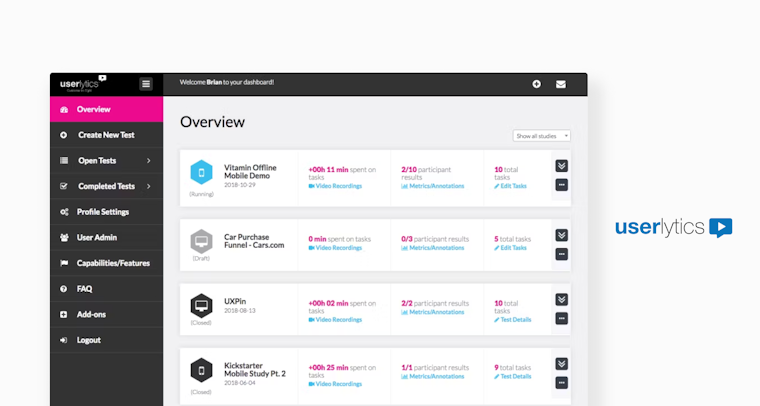
Userlytics is a user experience testing platform designed to help you identify usability issues and improve customer experience. With both moderated and unmoderated testing options, it lets you collect detailed feedback through video, audio, and screen recordings. The platform supports usability testing on websites, mobile apps, and prototypes.
Pros
- Panel of over two million participants
- Video analysis tools, including time-stamps and transcripts
- Various UX research methods, including questionnaires, card sorting, and tree testing
Cons
- No multilingual transcription option
- Credit system divides credits between Userlytics testers and user-provided participants, making it confusing to maximize your spend and can lead to unused credits
- Pay-as-you-go pricing can add up quickly, making it more suited to sporadic testing
Pricing
Userlytics pricing can be confusing, but we’ve done the research so you don’t have to.
Premium and Advanced plans require you to provide your own research participants. Enterprise and Custom include access to the Userlytics participant panel. Project-based pricing is suitable for one-off studies.
Project-based | Premium | Advanced | Enterprise | Custom |
$99/session One-off projects | $499/month - Unlimited unmoderated (30 minutes) sessions - Unlimited quantitative sessions (15 minutes) - Bring your own participants | $999/month - Unlimited unmoderated (60 minutes) sessions - Unlimited quantitative (60 minutes) sessions - 50 moderated sessions - Bring your own participants - Panel participant sessions available at $19/session | Usage-based approach, pricing starts at $3,500/month - Unlimited Admin & User accounts | Custom pricing and feature set |
Userlytics vs. dscout
Userlytics offers a wider range of research methods than dscout, including card sorting and accessibility testing. With a large participant pool, Userlytics provides access to diverse user feedback. In contrast, dscout’s smaller, U.S.-centric panel of 530,000 participants might limit insights for teams targeting international audiences.
One Userlytics user shares they have been using Userlytics for five years: "The tool has improved quite a bit in terms of functionality and usability." However, another user shares that “[Userlytics] has continually been behind the curve on visualizing the data.” While the platform’s come a long way, it still seems to be missing some vital components for UX researchers.
The verdict: Userlytics is a solid option if you’re willing to pay for access to their participant pool, or want to run one-off tests. Meanwhile, dscout works better for enterprise teams focused on qualitative, U.S.-specific research.
3. UserTesting: Best for bigger budgets
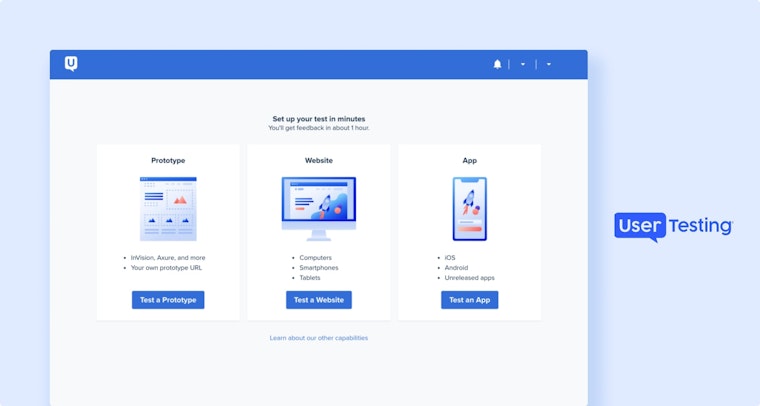
UserTesting supports both moderated and unmoderated tests, with its primary feature being Live Conversation—real-time interviews via video conferencing tools like Zoom. The platform also offers scheduling and reminder features to simplify the process.
UserTesting’s analytics suite includes features like sentiment analysis, click maps, and path flows, providing actionable insights into user behavior.
Pros
- Drag-and-drop customizable templates
- Global pool of participants, as well as invite-only networks
- Auto-generated analytics for quantitative data
Cons
- Pricing is among the highest in the market
- Users report concerns around participant quality
- Frequent complaints around the export-to-Excel feature for reporting
Pricing
UserTesting doesn’t publicly share its pricing, though users have reported that plans start at approximately $20,000 per seat/year.
Essentials | Advanced | Ultimate |
- Test builder and template gallery - Demographic filters and screener - Dashboard and metrics - Transcripts - Integrations with Slack, Jira, and Trello | Everything in Essentials, plus: - Test plan and audience management - Live Conversation - Interactive path flows and click maps - Sentiment analysis - Unlimited workspaces | Everything in Advanced, plus: - Card sorting and tree testing - Onboard and manage custom audiences - Secure prototype testing - Smart tags - Approval flow |
UserTesting vs. dscout
When it comes to participant recruitment, UserTesting’s global Contributor Network offers worldwide testers, while dscout’s smaller, U.S.-centric pool is better suited for studies targeting this specific region. However, reviews frequently flag participant quality as a concern, which could be due to UserTesting’s promotion as a pay-to-test service.
UserTesting’s surrounding features for interviews make it a go-to option for moderated testing, but some users note the transcription feature needs improvement, while other users find creating highlight reels “quite tedious."
The verdict: Both platforms are better suited for large teams with substantial budgets. Choose UserTesting if you’re a large enterprise with a roomy budget and a need for global participant access.
4. Optimal Workshop: Best for focusing solely on information architecture
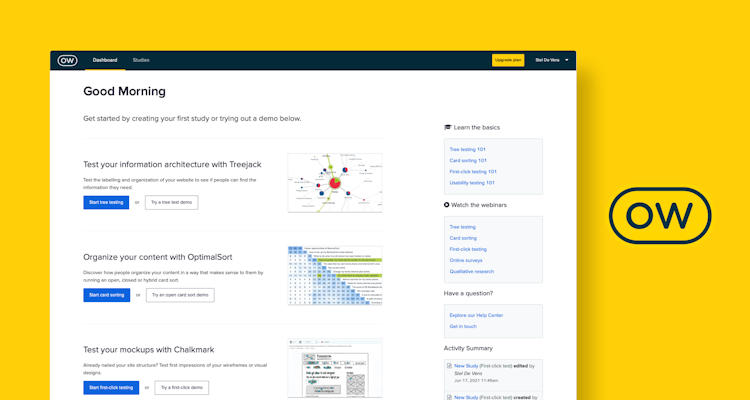
Optimal Workshop focuses on information architecture (IA) assessment, offering card sorting and tree testing to gather qualitative and quantitative user feedback on the structure of your product or website. The platform also provides first-click testing and UX surveys, allowing for another angle of analysis for user interactions.
Pros
- Prioritizes information architecture testing with card sorting, tree testing, first-click testing, and survey capabilities
- Provides a participant recruitment service with promised four-hour response turnaround
Cons
- Doesn’t support live website testing, limiting post-launch usability assessments
- Heatmaps lack a scroll map feature, preventing analysis of how far users scroll on a page
- Participant recruitment costs start at $10 per participant, which is higher compared to competitors
Pricing
Individual | Teams | Enterprise |
$199/month (7 days free trial)($107/month when billed annually) - 2 live studies - Tree testing - Card sorting - Optimal Academy | Custom pricing Includes everything in Individual plus: - First-click testing - Prototype testing - Surveys - Qualitative insights | Custom pricing Includes everything in Team plus: - Administrator controls - Dedicated Customer Success Manager - Multiple workspaces - Optimal Academy - Private projects - Single Sign-On - Tailored onboarding |
Optimal Workshop vs. dscout
In terms of features, Optimal Workshop and dscout are fairly distinct: Optimal Workshop focuses on researching a website’s information organization, while dscout offers a range of qualitative research tools.
One Optimal Workshop user shares, “There are a lot of test types that are offered and lots of ways to customize them to your needs.” However, users do report some issues with test participants. “Not all participants who take part in the survey take the survey seriously. A lot of time goes to waste on filtering this out.”
The verdict: In terms of pricing, both platforms are on the high end. Optimal Workshop is the better choice if you’re focusing specifically on IA, especially in the early stages of development. For a tool to suit additional use cases, you’re better off with another alternative from this list.
5. Hotjar: Best heatmaps for behavior analytics

Hotjar is a product and user behavior analytics tool that provides visual insights into user interactions on websites and apps. Its primary features include heatmaps and session recordings, allowing teams to track metrics like click frequency and cursor movement. Plus, Hotjar's API lets you export responses to various tools, integrating them into your existing workflows.
Pros
- Visual data helps identify high-engagement on your website or product
- Screen recordings of on-page interactions
- Integrates with tools like Slack, Google Analytics, and Jira
Cons
- Pricing plans can be expensive, as they depend on the features and number of daily sessions required
- Additional testing methods, such as user interviews or surveys, are necessary to fully understand user behavior and expectations
Pricing
Free | Plus | Business | Scale |
$0 - Unlimited heatmaps | $32/month Everything in Free, plus: | $80/month Everything in Plus, and: | $171/month Everything in Business, and: - Funnels and Trends - Console tracking (Errors) - Entered text and error filters - Hotjar API: automate user lookup and deletion - Webhooks - SAML single sign-on (SSO) - Dedicated customer success manager - Priority support |
Hotjar vs. dscout
Hotjar's strengths lie in its laser focus on behavioral data. However, it lacks options for usability testing and only works for live websites—a significant drawback for teams that want user input from the very start of the product design and development process.
It’s also worth noting the steep learning curve, with users complaining that “it can take some time to learn the platform”. Other users report that Hotjar can “take a toll on website performance”.
The verdict: Hotjar likely offers better value for money for those prioritizing cost-effectiveness and a balance of quantitative and qualitative research tools focused on user behavior. However, it does miss the key functionalities you need for comprehensive user research. If live product analytics is your focus, then Hotjar fits the bill.
6. Lookback: Best for remote ethnography
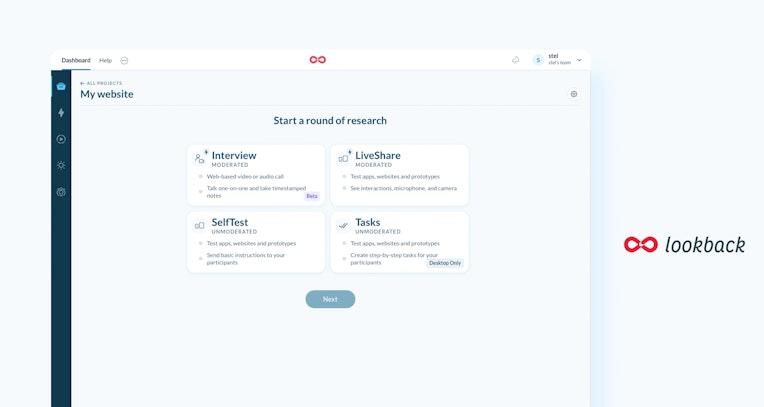
Lookback allows for both moderated and unmoderated usability testing across mobile and desktop devices. You can run various studies, including 1:1 interviews, remote ethnographic research, card sorting, tree testing, and diary studies.
Pros
- Offers private project options for sensitive research
- Supports testing across mobile, desktop, and tablet devices
- Good for remote moderated research, offering live observation with "behind the glass" viewing
Cons
- No participant recruitment services or panel— you’ll have to invite your existing pool of participants or additional tools
- Participants need to install plugins and use specific browsers
- No multiple-choice questions for participants
- No quantitative metrics such as time on task or system usability scales (SUS)
- No option to save videos locally—they can only be uploaded to the cloud
Pricing
Lookback’s plans are billed annually and come with a 60-day free trial:
Team | Insights Hub | Enterprise |
Starting at $149/month - From 100 to 150 sessions per year - All Freelance features, plus: - Make projects private - Get unlimited storage - In-session collaboration - Mention teammates - Share with stakeholders - Granular team access | Starting at $344/month - From 300 to 500 sessions a year - All Team features | Custom - Unlimited sessions - All Insights Hub features, plus: - Customization options - Customer success manager - Onboarding and professional services - Research expert and tailored training - SAML-based SSO |
Lookback vs. dscout
dscout offers a more comprehensive suite of research tools and native participant recruitment, while Lookback provides a more affordable option for basic usability testing and user interviews.
Lookback users highlight the ‘observation room’ feature as a favorite, noting that “many people can observe the interviews live and comment on what is happening with the interviewer.” However, most negative reviews highlight technical issues as the tool’s main drawback, with one user saying, “Users had trouble getting into a session through the tool. They needed to download the app and allow several permissions before they were connected.”
The verdict: Choose Lookback if you have your own participant pool, primarily need user interview tools, and are working with a smaller budget or as a freelancer.
7. Loop11: Best for cross-platform testing
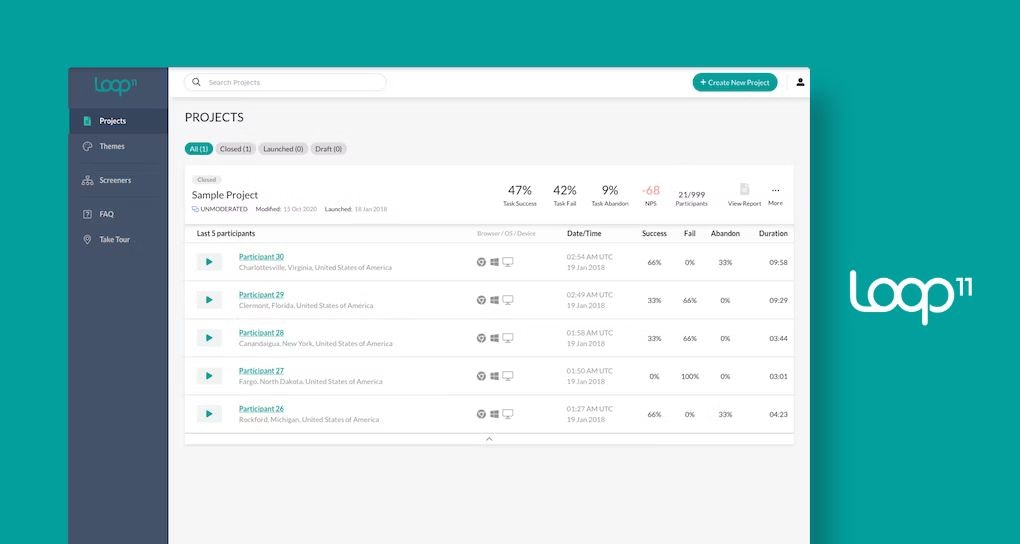
Loop11 is a usability testing platform that enables businesses to conduct both moderated and unmoderated tests on websites and prototypes across various devices. It offers features such as A/B testing, heatmaps, session recordings, and clickstream analytics.
Pros
- Test on desktop, mobile, and tablet
- Supports both moderated and unmoderated remote testing
- AI project creator can help setup tests
Cons
- The subscription model may be costly for smaller organizations or projects
- Tests cannot be edited once launched—meaning you must delete a test completely before rebuilding
- Very limited integration options
Pricing
Rapid Insights | Pro | Enterprise |
$179/month - Moderated and unmoderated tests - Test on multiple devices - Unlimited questions, tasks, and test duration - Limited projects/month: 3 - Maximum project participants: 10 - Maximum moderated test viewers: 3 - Can bring your own users - Create highlight reels and timestamped notes - Available test methods: 5 seconds and first clicks - AI summaries and transcriptions | $358/month All Rapid Insights features, plus: - 10 projects/month - Maximum project participants: 100 - Screeners - Access heatmaps, clickstreams, and paths - Export your data - Download video and audio - Priority chat support | $533/month All Pro features, plus: - Unlimited projects, participants, and viewers - Single Sign-On (SSO) - Connect to Slack - Report segments - Enterprise security |
Loop 11 vs. dscout
Loop11 primarily focuses on usability testing and user experience research. The platform also has several recruitment options, including panels from User Interviews, TestingTime, and Prolific, its own Loop11 Panel of qualified participants, or inviting your own participants.
Compared to dscout, Loop11 is more suited to teams pursuing quantitative research who are looking to test cross-platform. However, some users are wholeheartedly disappointed in the platform, stating, “It has been a poor tool overall, with aspects that need to be improved.”
The verdict: Choose Loop11 if your focus is on usability testing, but consider other options on our list if you’re after a wider variety of testing methodologies.
8. Lyssna: Best for pay-per-answer user testing
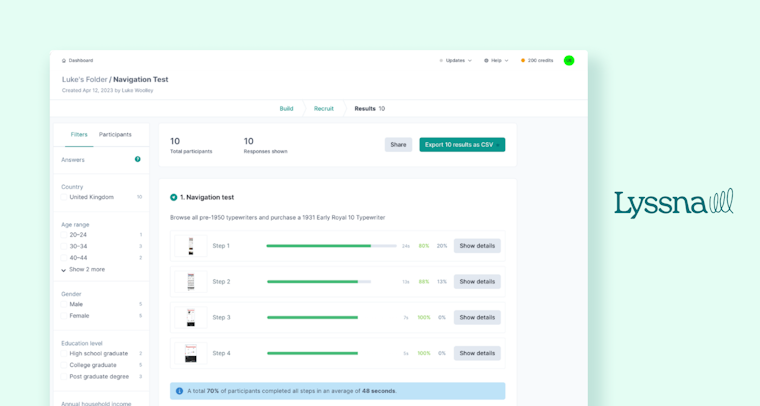
Lyssna (formerly UsabilityHub) offers usability testing methods including card sorting, first-click testing, five-second testing, preference testing, and prototype testing. For qualitative research, Lyssna offer surveys and user interviews.
Pros
- Integrations with Figma and Adobe XD
- Rapid turnaround of test results within 2–4 hours
- Generative AI features for transcription and translation of interviews
Cons
- Doesn't support native app testing
- Majority U.S.-based participant panel, limiting global audiences
- Users flag quality concerns with the participant panel
Pricing
Free | Basic | Pro | Enterprise |
|---|---|---|---|
$0 - 3 Seats - Unlimited tests, surveys, and interview studies - Max 15 answers/link -Length/test: 2 mins max - Live chat support - Panel access | $75/month - 3 seats included, 10 seats max
- Unlimited responses - Length/test: 5 mins max - CSV export - Variation sets for running the same test on design iterations - Remove Lyssna branding | $175/month - 5 seats included, 15 seats max
- Conditional logic - Hidden fields - Auto-set recruitment limits - Custom branding - Team management | Custom All Pro features, plus: - Custom password policy - SAML SSO - Security audits - Priority support - Custom terms |
Lyssna vs. dscout
Lyssna focuses on quick, quantitative usability testing and is more affordable for smaller teams and projects compared to dscout.
The platform receives mixed reviews when it comes to the testing pool, with one Lyssna user mentioning that “Lyssna's pool of testers is speedy, and provides clear feedback,” while another states “the quality of the responses was very poor. I did two tests. I had to cancel the first one as the responses coming in were useless.”
The verdict: Choose Lyssna if you need quick tests and have a smaller budget or only conduct occasional research. If you’re looking for comprehensive research options or a reliable participant panel, other tools on our list may be a better option.
Why look for an alternative to dscout?
dscout is a perfectly good option for qualitative user research, but it doesn’t always deliver when you need more robust, scalable tools. Here’s where it often falls short:
- Limited quantitative research tools mean you need to invest in multiple platforms
- Lack of integration capabilities create workflow inefficiencies
- High costs make it hard to scale research as you grow
Let’s take a look at each of these:
1. dscout has limited quantitative research tools
dscout is good at capturing stories, feelings, and user motivations through live user interviews and diary studies. But if you need hard numbers—like click-through rates, completion times, or usability scores—you’re out of luck. You’ll need to rely on extra tools to fill that gap, which can complicate your UX workflow, increase costs, and slow down your decision-making process.
2. dscout lacks integration capabilities
While dscout connects with a few popular tools—Figma, Slack, and Miro—this might not be enough if your design team uses another prototyping tool (e.g. Sketch, Axure), or your research team is looking to cross-reference insights with product analytics (e.g. Amplitude, Atlassian). Consider whether the time spent manually transferring data or patching together reports from multiple sources is worth it.
3. dscout doesn’t grow with your business
dscout doesn’t publish its pricing details, so if you’re looking to compare pricing options of UX research tools, you’ll have to look online. According to reports, a single project can start at around $3,000, with annual costs sometimes averaging around $60,000/year. A Reddit user has reported that the Enterprise plan starts at $75,000/year.
To make things more complicated, dscout bases its pricing on multiple factors like user seats, activity credits, and support levels. While this adds flexibility, it also increases unpredictable costs—and sets up your team to run out of budget just as you ramp up activity to grow your product.
How to choose an alternative to dscout
Choosing the right alternative to dscout depends on your team’s unique research needs, priorities, and budget. Here’s how to choose a research platform that fits your team:
- Research methods: If you rely on both qualitative and quantitative data, look for a platform that offers balance. Choose a platform like Maze or Userlytics if you need detailed product metrics alongside qualitative insights.
- Pricing transparency: One of dscout’s biggest drawbacks is its high pricing. If budget predictability matters to your team, prioritize tools with transparent and flexible pricing.
- Participant recruitment: If global reach is important, consider tools like Maze, UserTesting, or Optimal Workshop, which offer broad participant pools and quick turnaround times.
- Workflow integrations: When you’re juggling multiple tools and workflows, you need something that plays nicely with design platforms like Figma or collaboration hubs like Slack. Tools like Maze and Hotjar offer multiple integrations with many third-party applications.
Propel your product with user insights from Maze
While dscout is a viable option for qualitative research, its limitations in quantitative methods and integrations can hold back your team.
Maze addresses these challenges. With a complete suite of research tools, including moderated interviews, prototype testing, and surveys, Maze empowers you to validate ideas quickly. Its seamless integration with your team’s tech stack, plus AI-powered analysis saves time and ensures your decisions are backed by both qualitative and quantitative insights.
Frequently asked questions about dscout alternatives
What tool is similar to dscout?
What tool is similar to dscout?
Platforms like Maze, UserTesting, Userlytics, and Optimal Workshop are similar to dscout. These tools provide usability testing, participant recruitment, and options for both moderated and unmoderated research.
What’s the difference between dscout and Maze?
What’s the difference between dscout and Maze?
dscout focuses primarily on qualitative research, with features like diary studies and live interviews to capture in-depth user insights. Maze, on the other hand, balances both qualitative and quantitative research, offering usability testing, prototype testing, surveys, card sorting, tree testing, and seamless integrations with design tools like Figma. It’s also more cost-transparent compared to dscout’s pricing model, and offers a more valuable tool for a lower cost.
How much does dscout cost?
How much does dscout cost?
dscout doesn’t publicly disclose its pricing, but reports suggest that costs start at around $3,000 per project, with annual subscriptions reportedly starting at $75,000 for enterprise-level plans.
